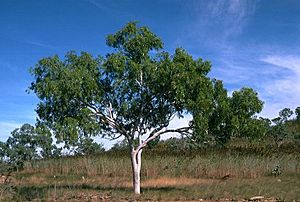Kimberley gum facts for kids
Quick facts for kids Kimberley gum |
|
|---|---|
 |
|
| Eucalyptus confluens near Windjana Gorge | |
| Scientific classification | |
| Genus: |
Eucalyptus
|
| Species: |
confluens
|
The Kimberley gum (scientific name: Eucalyptus confluens) is a type of small tree found only in northern Australia. It gets its name from the Kimberley area in Western Australia, where it grows. You can also find it in nearby parts of the Northern Territory.
This tree is easy to spot with its smooth, powdery white bark. It has long, narrow adult leaves, round flower buds that grow in groups of seven, and pretty white flowers. Its fruit looks like a small cup.
Contents
What the Kimberley Gum Looks Like
The Kimberley gum is a tree that usually grows between 3 and 10 meters (about 10 to 33 feet) tall. It has a special woody swelling at its base called a lignotuber. This helps the tree regrow if it gets damaged, for example, by a bushfire.
Bark and Leaves
The bark of the Kimberley gum is smooth and feels powdery. It is mostly white, sometimes with a pale pink color underneath. This smooth bark covers the entire tree.
Young plants and new shoots that grow from the base (called coppice) have stems that are somewhat square. Their leaves are dull green and shaped like a wide egg or almost round. These young leaves are about 40 to 75 millimeters long and 30 to 45 millimeters wide.
As the tree grows, its adult leaves change. They become glossy green on both sides and are shaped like a spear (lance-shaped). These adult leaves are longer, about 60 to 150 millimeters long and 9 to 22 millimeters wide. Each leaf has a stem, called a petiole, which is about 10 to 25 millimeters long.
Flowers and Fruit
The flower buds of the Kimberley gum grow in groups of seven. They are found where the leaves meet the stem. Each group of buds sits on a small stalk, called a peduncle, which is about 4 to 10 millimeters long. The individual buds are either directly attached or have a very short stalk.
When the buds are ready to open, they are oval or almost round. They are about 5 to 8 millimeters long and 3 to 5 millimeters wide. Each bud has a rounded or cone-shaped cap, called an operculum, which protects the flower inside.
Kimberley gum trees usually flower between February and March. Their flowers are white. After flowering, the tree produces woody fruit. This fruit is shaped like a cup or half a sphere. It is about 4 to 7 millimeters long and 6 to 7 millimeters wide. When the fruit opens, its parts are level with or slightly above the rim.
Naming the Kimberley Gum
The scientific name Eucalyptus confluens was officially described in 1916 by a botanist named Joseph Maiden. He used an earlier, incomplete description from William Vincent Fitzgerald.
The word confluens comes from Latin and means "a place where two streams meet." This name refers to how the veins in the leaves are arranged.
Similar Trees
The Kimberley gum looks a lot like two other white gum trees found in the same area. These are the Eucalyptus brevifolia and Eucalyptus gregoriensis.
Where the Kimberley Gum Lives
The Kimberley gum grows in two separate areas, meaning its populations are not connected. Both areas are in the Kimberley region of Western Australia. You can also find it in parts of the Northern Territory that are close by.
One group of these trees grows in the Wunaamin Miliwundi Ranges. The other group is found near Lake Argyle, which is on the border between Western Australia and the Northern Territory.
Kimberley gums often grow on rocky hillsides or ridges. They prefer sandy, stony soils that are found over sandstone, granite, or quartzite rock.

